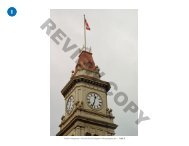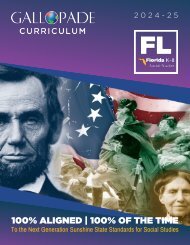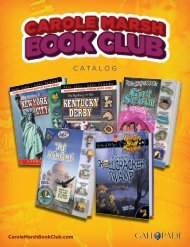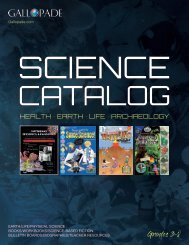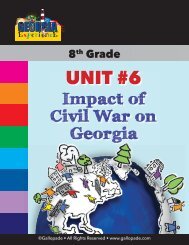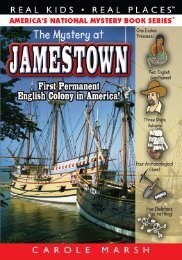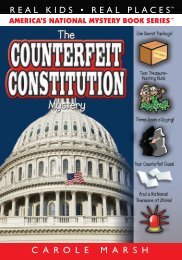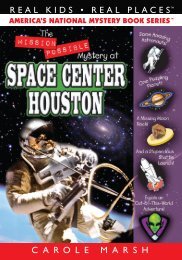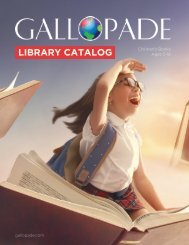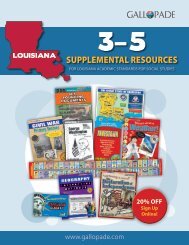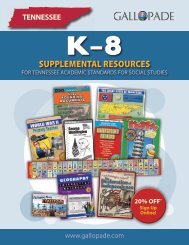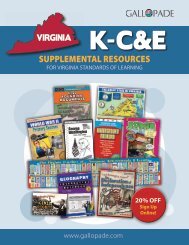Virginia Curriculum Catalog
You also want an ePaper? Increase the reach of your titles
YUMPU automatically turns print PDFs into web optimized ePapers that Google loves.
<strong>Virginia</strong> Experience • U.S. History II • ©Carole Marsh/Gallopade • www.gallopade.com • Page 2<br />
<strong>Virginia</strong> Experience • U.S. History II • ©Carole Marsh/Gallopade • www.gallopade.com • Page 7<br />
<strong>Virginia</strong> Experience • U.S. History II • ©Carole Marsh/Gallopade • www.gallopade.com • Page 5<br />
<strong>Virginia</strong> Experience • U.S. History II • ©Carole Marsh/Gallopade • www.gallopade.com • Page 1<br />
<strong>Virginia</strong> Experience • U.S. History II • ©Carole Marsh/Gallopade • www.gallopade.com • Page 3<br />
<strong>Virginia</strong> Experience • U.S. History II • ©Carole Marsh/Gallopade • www.gallopade.com • Page 4<br />
2<br />
Building the Transcontinental RailroadThe Weeping Time<br />
When I Grow Up, I Want to Be a Cowboy<br />
It was a race to see who could be the fastest to the finish line. Spikes were driven into<br />
How<br />
the<br />
would you like to be sold like livestock, as if you were a mule? No one would,<br />
Many former slaves left the South and moved west to work on ranches in Texas after<br />
ground; tracks were laid across mountains and plains. It was a project that would change<br />
of course, but it happened…<br />
the Civil War. Driving cattle was a difficult job. It was lonely, dirty, and sometimes<br />
America forever…<br />
dangerous. Imagine how the “Help-Wanted” advertisement might have read...<br />
In 1859 on a racetrack in Savannah, Georgia, the largest sale of slaves ever held in<br />
The construction of the Transcontinental Railroad was one of the greatest<br />
Help Wanted: Cowboys<br />
the United States took place. On two rainy days, about 430 men, women, and children<br />
technological accomplishments in America’s history. Construction started after the<br />
$1 a Day<br />
were sold to the highest bidder.<br />
Civil War ended in order to extend existing tracks in the Great Plains over the western<br />
Attention: Young Men, 15 to 25 years old<br />
mountains, plains, deserts, and rivers. Only then could someone easily and quickly travel Pierce Butler, a plantation owner, had wasted his inheritance on an expensive Twelve cowhands are needed to herd 3,000 longhorn cattle. We’ll travel on horseback,<br />
from the eastern United States to the West. 5<br />
lifestyle. His land and buildings were sold to pay some of his bills, 3but he still owed more<br />
10 to 15 miles a day for two months. We’ll follow the Chisholm Trail. You must be a<br />
money. He needed to sell many of his<br />
Without an unbroken rail route to the<br />
slaves to get out of debt.<br />
good rider and able to rope a calf while riding your horse. You must be willing to herd<br />
Pacific Coast, the trip from the East lasted several<br />
across deep water. The boss will provide lunch and dinner at the chuck wagon. Be<br />
months. It was difficult, expensive, and sometimes<br />
The major slave auction was prepared to take a two-hour turn each night watching the cattle. Singers and storytellers<br />
dangerous. Many people instead chose to take<br />
advertised widely for weeks and drew<br />
are encouraged to apply.<br />
a ship south around the tip of South America<br />
huge crowds to Savannah. Butler had<br />
and then north. But that approach also required<br />
his slaves brought to the racetrack, where<br />
several months and was costly.<br />
they stayed in shacks or horse stalls for Driving a herd of cattle was not easy! Keeping the cattle moving in the right<br />
days or weeks until the sale began. direction could be dangerous.<br />
It didn’t take much to spook<br />
Two railroad companies would start racing<br />
One observer said, “It is a dreadful a Texas longhorn. A loud<br />
toward each other from northern California to<br />
affair….” Not all families were sold noise, like thunder, might<br />
eastern Nebraska. The Central Pacific started<br />
together. Parents and children were cause a stampede. Imagine<br />
laying track from west to east, while the Union<br />
soon parted. So were brothers and 3,000 cattle running on<br />
Pacific built from east to west. The companies<br />
sisters. That observer asked, “Can such the open plain, trampling<br />
competed to be the first to reach Promontory<br />
a system [slavery] endure?” And yet everything he in their path! You’d<br />
Point, Utah, where their tracks would joint!<br />
added, “Slavery is better for them and have to round them up again.<br />
for us….”<br />
Sometimes a cowboy could<br />
Building the railroad was difficult for both companies. The Central Pacific had to<br />
keep them calm by singing.<br />
lay track through the Rocky Mountains. Workers blasted through rock with dynamite Surely, the men, women, boys, and girls standing in the rain that day disagreed.<br />
and built tunnels to make room for the railroad. The Union Pacific’s work was less Many tried hard to be purchased by “good” masters. They showed off their teeth or<br />
There were other dangers.<br />
challenging because it was building across flat prairies. The railroad companies lay an muscles. Others just sat sadly in the rain.<br />
Rattlesnakes, cattle thieves, and<br />
average of 1 mile of track a day.<br />
What happened next? New owners and their new slaves left together. Champagne hostile Indians topped the list. A<br />
On on May 10, 1869, the Central Pacific and Union Pacific crews met at bottles were popped to celebrate the $303,850 made from the sale.<br />
common cause of death for a cowboy was being dragged by his horse after falling off.<br />
Promontory Point. The last spike nailed into the track was made of gold! News of the<br />
The rain stopped. Africans who had been kidnapped and brought against their will Most of the day, you would ride alongside the cattle alone. After the evening meal,<br />
completied Transcontinental Railroad spread quickly, and Americans celebrated the<br />
to work in the fields or do household chores would continue to work hard. you’d sit around the fire and tell stories. Then you’d grab your blanket and get some<br />
joining of East and West.<br />
sleep. Your buddy would wake you when it was your turn at watch.<br />
One day, the terrible practice of slavery would come to an end in America, but not<br />
The creation of the railroad changed the United States forever! Americans could on this day at a racetrack in Savannah.<br />
travel from the East to the West in only a few days and for as little as $150 for a nice seat.<br />
The “Wild” West attracted many new settlers, bustling towns, and settlements along the<br />
Higher-Order Thinking<br />
railroad tracks.<br />
Higher-Order Thinking<br />
Develop a logical argument as to why men would want to become cowboys, since it was<br />
Higher-Order Thinking<br />
What can you conclude about the observer’s point of view of slavery? Cite evidence from<br />
a pretty difficult life.<br />
What effects did the completion of the Transcontinental Railroad have on life in America? the text to support your answer.<br />
Cite evidence from the text that is stated explicitly or inferred.<br />
Tech Tools<br />
Incorporate classroom and “Build Your Own Tech” technology<br />
into your Social Studies instruction with ideas, tips, and links for<br />
integrating research, blogs, flashcards, videos, and more into<br />
instruction and assessments.<br />
Enrichment Pack<br />
Engage students with broad word and world knowledge through<br />
robust reading passages that help them comprehend challenging<br />
material with higher-order thinking and prompts to encourage<br />
class or small group discussion or to inspire writing assignments.<br />
7<br />
The Invention of Paper Living in the Wild, Wild West Recipe for a GREAT Map!<br />
Did you know that Benjamin Franklin was the first paper<br />
The few wooden buildings lining the dirt road didn’t look like much. They had signs like Just as a recipe combines parts to make a whole dish, so does a map include many<br />
merchant in America? Or that he helped start paper mills in<br />
“General Store,” “Blacksmith,” and “Hotel.” The Wild West town looked more like a important pieces to give you the big picture…<br />
<strong>Virginia</strong>? Let’s learn about the history of paper…<br />
dusty row of barns than a bustling city…<br />
A map is a very important geographic tool that shows<br />
Paper is everywhere in a modern society. Just a few of<br />
The towns of the Wild West may have been small and simple, but they were the detailed information about an area. The area can be as small<br />
the ways different types of paper products are used include<br />
center of a pioneer’s life. Just about every Wild West town featured the same businesses<br />
as your classroom or as big as the entire Earth! A map may<br />
writing paper, gift wrap, book pages, Kleenex, and paper<br />
that were important to pioneer life:<br />
show roads, landmarks, routes for transportation, and different<br />
money. Paper is a vital resource for the United States and<br />
for the entire world!<br />
1<br />
Blacksmith and stables: Since horses were the 4<br />
landforms such as mountains and rivers.<br />
main type of transportation, each Wild West town<br />
There are four main parts to a map you need to remember:<br />
It is believed the world’s first paper was created by<br />
needed a blacksmith who could make shoes for<br />
the ancient Egyptians. They used strips from a papyrus<br />
the map title, map key, scale, and compass rose.<br />
the horses, and a stable where horses were fed<br />
plant. These strips were moistened and then made into<br />
and watered.<br />
The map title tells what this map displays. A map key or map legend is a chart that<br />
a criss-cross pattern that the Egyptians pressed into<br />
explains what the symbols on a map mean. On many maps, for example, a black dot<br />
sheets. The word “paper” comes from “papyrus.”<br />
General store: The general store provided the<br />
stands for a city, a star stands for a state’s capital, airplanes stand for airports, and black or<br />
However, the kind of paper the Egyptians made did not<br />
supplies pioneers needed for survival. The stores<br />
yellow lines stand for highways, roads, or<br />
look and feel anything like our paper products of today. Paper that is closest to<br />
were usually very small—the size of an average<br />
streets. The kind of map will determine<br />
modern paper was first made in China nearly 2,000 years ago.<br />
classroom. They carried goods like rugs, cooking<br />
what kind of symbols are needed for the<br />
stoves, candles, hammers, and children’s toys.<br />
map legend.<br />
The Chinese did not experiment with paper for writing. Instead, they needed<br />
a different kind of paper to make clothing and blankets!<br />
Church: The church was the center of town. It<br />
Many maps also have a compass<br />
was a place where settlers could worship and<br />
The Chinese created paper by boiling plants until they became pulp. The<br />
rose, which is a tool that shows<br />
talk with their neighbors. A pastor might have to<br />
pulp would then be sifted through a screen.<br />
directions. The cardinal directions<br />
travel to several different towns to preach—all in<br />
are north, south, east, and west. The<br />
Next, the pulp would harden and dry. The sheets of pulp would be lifted one day!<br />
intermediate directions are the points<br />
from the screen to be used as paper. This paper was very thick and would not<br />
bend like the paper we use today. It was not very smooth, either.<br />
Hotel: The hotel was important for visitors. Since most pioneer houses were one-room<br />
in between the cardinal directions:<br />
log cabins, they did not have room for guests. The hotel room might cost 50 cents per<br />
northeast, northwest, southeast, and<br />
When they wanted to write, the Chinese would scratch or chisel on night, plus 50 cents for lunch and dinner!<br />
southwest.<br />
wood, bamboo, or stone.<br />
Most maps will also have a scale.<br />
Lumberyard/sawmill: Lumberyards were important businesses in prairie towns where<br />
there weren’t many trees to cut down. Pioneers got wood from the lumberyard to<br />
A map scale is a tool that compares distance on a map to the actual distance on Earth. The<br />
build their cabins. Sawmills were important because they cut wood much faster than scale helps the person reading the map figure out real-life distances. For example, suppose<br />
pioneers could cut by hand.<br />
there is a map on which 1 inch represents 1 mile. If two places on that map are 5 inches<br />
Higher-Order Thinking<br />
apart, that means they are 5 miles apart on Earth.<br />
The text says the Chinese used wood, bamboo, or stone for writing. What about School: Wild West towns usually had small, one-room schoolhouses. Students from<br />
writing on those materials might motivate the Chinese to experiment with other kinds ages of 6 to 16 would all learn together from one teacher. Their subjects included reading,<br />
materials?<br />
writing, and arithmetic.<br />
Papyrus<br />
Higher-Order Thinking<br />
Give the four main parts of a map and explain why each is important in understanding<br />
Higher-Order Thinking<br />
how to read a map.<br />
Business tycoon Harvey Firestone once said, “The way of the pioneer is always rough.”<br />
He was referring to business pioneers, but use specific examples from the text and explain<br />
how a real pioneer’s life was a rough one.<br />
Graphic Organizers<br />
Includes over 20 printable or projectable ready-to-use graphic<br />
organizers to increase student comprehension. Students understand<br />
concepts and connections.<br />
Additional Features<br />
• Students can complete their work directly online and use digital<br />
annotation tools.<br />
• The Read Aloud feature supports comprehension and fluency<br />
by having the text spoken aloud while students follow aloud.<br />
TEACHING<br />
TOOLS<br />
From day one, teachers have a comprehensive program<br />
that will prepare every student at every level. Our extensive<br />
teacher materials make it easy to build your daily<br />
lesson plan.<br />
Teaching Tools are organized to match Student Book units<br />
and chapters, making it simple to access the resources<br />
you want to use. Teaching Tools enhance instruction while<br />
easing the burden of your time. You get exactly what you<br />
need when you need it.<br />
K-C&E | Print + DIGITAL<br />
21st Century Skills — Projects and Performance Tasks<br />
Activities can be used as part of an ongoing collaborative<br />
process throughout a unit or as a capstone project at<br />
the end of a unit combining Social Studies content and<br />
essential information into a higher-order thinking activity<br />
or assignment. Each project is easily adaptable to be as<br />
simple or elaborate as desired for your class.<br />
MULTIMEDIA<br />
RESOURCES<br />
Strategically selected resources go beyond the classroom to<br />
engage students with primary and secondary sources. These<br />
enhance lessons and illustrate key concepts with each source<br />
broken down by chapter to save you time.<br />
K-C&E | DIGITAL<br />
Varied Formats<br />
• Photographs<br />
• Diagrams<br />
• Infographics<br />
• Political cartoons<br />
• Paintings<br />
• Videos<br />
• Primary Sources<br />
• Internet Links<br />
Enhanced Learning<br />
• Boost Creativity<br />
• Encourage student<br />
engagement and<br />
collaboration<br />
• Creative alternatives for<br />
learning about specific<br />
topics<br />
• Videos help explain complex<br />
ideas<br />
• Assign as homework or inclass<br />
review<br />
pg.6 | gallopadecurriculum.com



